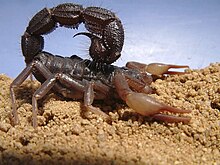User:Kkz zhou
| Ikitoxin | |
|---|---|
| Category | Ion channel toxin, Neurotoxin |
| Species | Parabuthus transvaalicus[1] |
| Target | voltage-gated sodium channel [1] |
| Symptoms | Unprovoked jumps |
| Sequence length | 58 AA [1] |
Ikitoxin is a neurotoxin from the venom of the South African Spitting scorpion (Parabuthus transvaalicus). Following ‘high dose’ intracerebroventricular injection into mice, it causes unprovoked jumps.[1]
Source[edit]

Ikitoxin is one of the many components, which can be isolated from the venom of the South African Spitting scorpion.[1] Other peptide toxins found in the venom include:birtoxin, moderately toxic but very abundant in the venom; dortoxin, a lethal peptide; bestoxin, which causes writhing in mice; and altitoxin, a highly depressant peptide.[2]
Chemistry[edit]
Ikitoxin is a birtoxin family peptide neurotoxin targeting sodium channels. Although identified as a long chain neurotoxin which usually has 64~70 residues with four disulfide bridges, ikitoxin, like birtoxin, has an exceptional smaller size (58 residues) with only three disulfide bridges.[3] Ikitoxin differs from birtoxin by a single amino acid: from glycine to glutamic acid at position 23, consistent with an apparent mass difference of 72 Da between the two peptides.[1]
Mode of action[edit]
Both ikitoxin and birtoxin are beta toxins, which bind to and trap the voltage-senseor of the channel at side 4. The binding of ikitoxin lowers the voltage threshold of sodium channels and produce a reduction in the current amplitude. The change in activation will lead to sodium channels opening at smaller depolarizations and result in increased excitability which may be responsible for the symptoms. [1] [3]
Toxicity[edit]
Ikitoxin, with only a single residue different from birtoxin, has a markedly reduced biological activity. In mice experiments intracerebroventricular administrationikitoxin, induced unprovoked jumps as observed in birtoxin injection at a 1000-fold lower concentration and the onset of jumps was much slower. Another difference between these toxins is that birtoxin produced convulsions, tremors, increased ventilation and, subsequently, death, whereas ikitoxin did not. [1] Both ikitoxin and birtoxin only seem to affect mammals. Injection of 0.002–4 μg toxin in mice did not show lethality .
Treatment[edit]
Ikitoxin is one of many neurotoxic polypeptide components in the venom of the South African Spitting scorpion and has a birtoxin-like structure. Antibodys against the N-terminus of the birtoxin protein structure has been shown to neutralize the venom of the South African spitting scorpion, and such antibodies may be useful clinically to treat envenomation.[4]
References[edit]
- ^ a b c d e f g h Inceoglu, B.; Hayashida, Y.; Lango, J.; Ishida, A.; Hammock, B. (2002). "A single charged surface residue modifies the activity of ikitoxin, a beta-type Na+ channel toxin from Parabuthus transvaalicus". European Journal of Biochemistry. 269 (22): 5369–5376. doi:10.1046/j.1432-1033.2002.03171.x. PMID 12423335.
- ^ Inceoglu, B.; Lango, J.; Pessah, I. N.; Hammock, B. D. (2005). "Three structurally related, highly potent, peptides from the venom of possess divergent biological activity". Toxicon. 45 (6): 727–733. doi:10.1016/j.toxicon.2005.01.020. ISSN 0041-0101. PMID 15804521.
{{cite journal}}: CS1 maint: date and year (link) - ^ a b Inceoglu, B.; Lango, J.; Wu, J.; Hawkins, P.; Southern, J.; Hammock, B.D. (2001). "Isolation and characterization of a novel type of neurotoxic peptide from the venom of the South African scorpion Parabuthus transvaalicus (Buthidae)". European Journal of Biochemistry. 268 (20): 5407–5413. doi:10.1046/j.0014-2956.2001.02479.x. PMID 11606203.
- ^ Inceoglu, Bora; Lango, Jozsef; Rabinovich, Alina; Whetstone, Paul; Hammock, Bruce D. (2006). "The neutralizing effect of a polyclonal antibody raised against the N-terminal eighteen-aminoacid residues of birtoxin towards the whole venom of Parabuthus transvaalicus". Toxicon. 47 (2): 144–149. doi:10.1016/j.toxicon.2005.08.018. ISSN 0041-0101. PMID 16356521.
{{cite journal}}: CS1 maint: date and year (link)
